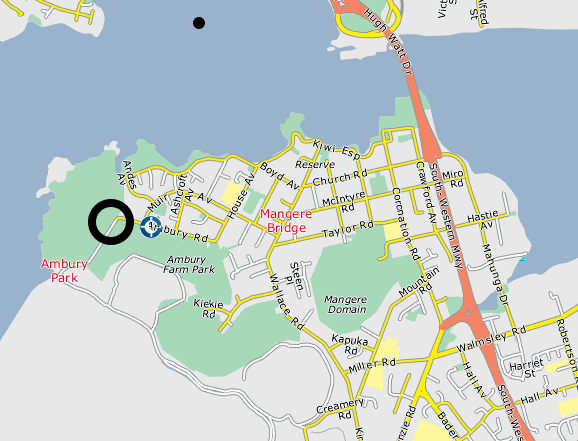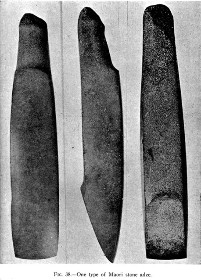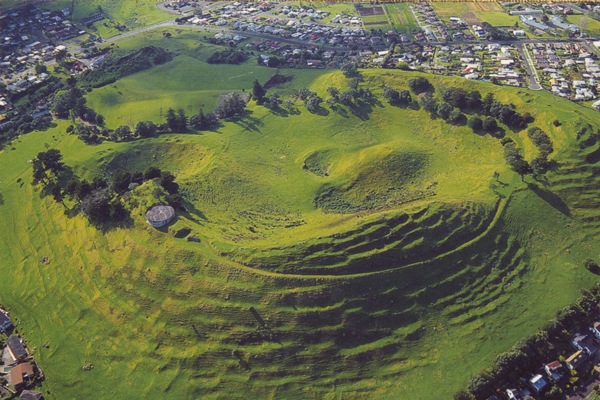Difference between revisions of "Ambury Regional Park"
(→Summary) |
(→Summary) |
||
| Line 2: | Line 2: | ||
== Summary == | == Summary == | ||
''' | ''' | ||
| − | Nearby Mangere Mountain was once the site of large fortified Māori pa and the area now known as Ambury Regional Park was used by Māori for gardening. Mangere Mountain erupted approximately 18,000 years ago and the park sits atop a lava field made fertile by ash from the volcano. The Archaeological record left behind is astounding and, for the most part, can be viewed by the public. In fact, Ambury Regional Park is the only place where publicly owned [[Maori Rock Art]] can be found. Due to the inherent depth of archaeological value held in Ambury, conservation of natural landscapes and the preservation of dense archaeological sites has been a concern for many in the region. An in-depth examination of a conservation effort presented by [http://www.lawas.co.nz/ Law Associates LTD] to the [http://www.arc.govt.nz/ Auckland Regional Council] can be found [https://docs.google.com/a/virginia.edu/viewer?a=v&pid=gmail&attid=0.1&thid=126f6d9dbf1deba6&mt=application%2Fpdf&url=https%3A%2F%2Fmail.google.com%2Fa%2Fvirginia.edu%2F%3Fui%3D2%26ik%3D2d3d24b0ea%26view%3Datt%26th%3D126f6d9dbf1deba6%26attid%3D0.1%26disp%3Dattd%26zw&sig=AHIEtbTzYU5KHyZaq0J0_an50ta-ijglEQ&AuthEventSource=SSO here.] | + | Nearby [http://www.mangeremountain.co.nz/ Mangere Mountain]was once the site of large fortified Māori pa and the area now known as Ambury Regional Park was used by Māori for gardening. [http://www.mangeremountain.co.nz/ Mangere Mountain]erupted approximately 18,000 years ago and the park sits atop a lava field made fertile by ash from the volcano. The Archaeological record left behind is astounding and, for the most part, can be viewed by the public. In fact, Ambury Regional Park is the only place where publicly owned [[Maori Rock Art]] can be found. Due to the inherent depth of archaeological value held in Ambury, conservation of natural landscapes and the preservation of dense archaeological sites has been a concern for many in the region. An in-depth examination of a conservation effort presented by [http://www.lawas.co.nz/ Law Associates LTD] to the [http://www.arc.govt.nz/ Auckland Regional Council] can be found [https://docs.google.com/a/virginia.edu/viewer?a=v&pid=gmail&attid=0.1&thid=126f6d9dbf1deba6&mt=application%2Fpdf&url=https%3A%2F%2Fmail.google.com%2Fa%2Fvirginia.edu%2F%3Fui%3D2%26ik%3D2d3d24b0ea%26view%3Datt%26th%3D126f6d9dbf1deba6%26attid%3D0.1%26disp%3Dattd%26zw&sig=AHIEtbTzYU5KHyZaq0J0_an50ta-ijglEQ&AuthEventSource=SSO here.] |
---- | ---- | ||
Revision as of 13:08, 23 February 2010
Summary
Nearby Mangere Mountainwas once the site of large fortified Māori pa and the area now known as Ambury Regional Park was used by Māori for gardening. Mangere Mountainerupted approximately 18,000 years ago and the park sits atop a lava field made fertile by ash from the volcano. The Archaeological record left behind is astounding and, for the most part, can be viewed by the public. In fact, Ambury Regional Park is the only place where publicly owned Maori Rock Art can be found. Due to the inherent depth of archaeological value held in Ambury, conservation of natural landscapes and the preservation of dense archaeological sites has been a concern for many in the region. An in-depth examination of a conservation effort presented by Law Associates LTD to the Auckland Regional Council can be found here.
Location
Ambury Regional Park is located just 15 kilometers from Central Auckland and rests on the ash-covered lava flow from Mangere Mountain.

Archaeology
Ambury Regional Park is regionally important as the only place in the Auckland region where Maori stone structures are found in public ownership. The Department of Conservation's draft Auckland Conservation Management Strategy lists Ambury and the Mangere area as containing undefended settlements, defended sites and gardens in a connected group of related sites of significant historic value.
The draft Strategy states that pa occupying volcanic cones with gardens on the surrounding lower-lying volcanic soils (such as the Mangere Mountain/Ambury complex) are probably the most distinctive historic sites in the isthmus area. Much attention has focussed on the stone structures at Ambury, and the garden areas have been mapped in detail (Rickard et al 1983). Stone walled fields are also present at Otuataua (Ihumatao) and Matukurua (south of McLaughlin's Mountain) (Department of Conservation, 1991).
Ninety five archaeological sites were recorded on Ambury Regional Park in 1981, the majority of which were midden and stone structures, including stone rows and mounds (Bulmer 1981). Caves were recorded as sites, as midden were often associated with them. Only four pits and terraces were recorded, reflecting the rocky nature of the land. The newly purchased School Paddock contains a cave and midden, which have now been fenced off with a stone wall.
In general, evidence of habitation is so dense that it should be suspected that archaeological remains may be found virtually anywhere along the coast.. The most intact group of archaeological features is located at the north eastern end of the park, accessed via Kiekie Rd. Here, stone mounds and garden walls are a prominent feature. Some of these sites were destroyed by works associated with laying the Marsden Point to Wiri Pipetech - MV oil pipeline - (Cramond and Nevin 1981). An archaeologist was present during excavations, and recorded destroyed sites (Lilburne 1982a, 1982b). A midden was described in detail (Adds and Brassey 1983), as well as an area of stoneworks and , earthworks (Lilburne 1982a, 1982b, Cox 1982). Rocks, particularly on the eastern park boundary, have been removed and used in constructing walls on neighbouring property.
Sites in good condition are also located around the western coastline of the park. Most obvious are stone rows. Rabbits are constantly unearthing midden sites at the park.
The construction of a bird viewing shelter was overseen by an archaeologist. A badly disturbed activity area associated with cooking and processing shellfish, and an area of stone clearing and gardening activities was recorded (Lawlor 1992).
The archaeological sites of the northeast and west of Ambury Regional Park are interpreted as two separate major concentrations of settlement. The former was relatively stone free extremely fertile volcanic soil, used predominantly for gardening. The coastal sites were probably associated with fishing activities. Both areas comprised sites relating to domestic living, such as house terraces, platforms and midden (MacDonald and Buhner 1981).
Most of the sites recorded were not individual features, but groups of features, as summarised in Table 3. Archaeological features were virtually continuous along the northern coast and in the southeastern area were probably extensive villages. It is likely, because of the good garden land, that the Ambury area was repeatedly if not continuously, occupied (MacDonald and Bulmer 1981). Detailed Archaeological site records are available from the New Zealand Archaeological Association Filekeeper at the Department of Conservation. The food produced on the flats of Ambury were stored in huge rua or pits on Mangere Mountain. The size of the pits and number of terraces (over 100) suggests that Mangere Mountain was the site of a small city, rather than a pa, and home to thousands of Maori people.
Remnants of stone walls radiate out from the base of the mountain, contiguous with those on the north eastern boundary of Ambury. The walls divided garden land and house sites among the families of the Ambury settlement and the pa.
Text Taken directly from: Ambury Regional Park Management Plan July 1994
Photog: unknown Maori History
History
Approximately one kilometre south-west of Ambury Regional Park is Puketutu Island. This island is also known as "Motu-a-Hiaroa" (Island of the Long Desired) and is claimed to have been populated by some of the earliest Maori inhabitants of Aotearoa i as far b. ack as 950 A.D.
Tradition has it that one of the earliest travellers from Hawaiki (generally thought to be the Society Islands), Toi-te-hua-tahi, also known as Toi-kairakau, landed his canoe at Whakatane in the Bay of Plenty around 1 125 AD. From there his iwi (people or tribe) spread, reaching the Auckland area (Tamaki-makau-rau) around 1 150 AD and visiting the inhabitants of Motu-a- Hiaroa.
Toi's iwi merged with those already inhabiting the area, a people who were known by several names, one being Nga Oho who were the dominant people in the Tamaki-makau-rau area. Motu-a-Hiaroa became an important centre for them. The island was a stronghold, partially isolated and easily fortified, with fertile soil and close to excellent fishing grounds. Motu-a-Hiaroa became prized by the tahgata whenua (people of the land) and the tuahu (ceremonial place) on the island became very important, holding great mana (spiritual importance and prestige) for the people of the surrounding area. It was also known to be a home of the important Tohunga (spiritual leader) Rakataura, and so the summit of the island is called f e Tomata a Rakataura.
Motu-a-Hiaroa became so populated that people settled in the surrounding coastal areas, including the land now in Ambury Regional Park. Many of the earliest archaeological sites at Ambury may have been a result of this habitation.
The arrival of what is now known as the Great Fleet in Aotearoa occurred around 1350 AD. People from four canoes had an effect on Tamaki-makau-rau history; the Tainui, Arawa, Aotea and the Mataatua. The Tainui, however, became the most important for the Manukau area. The Tainui sailed into the Hauraki Gulf and the Waitemata Harbour and up the Tamaki River. At Otahuhu the canoe was drawn across the portage route into the Manukau Harbour. Continuing past the area where Ambury Regional Park is now located, they made their way to Kawhia. The people settled there and ultimately spread to the Waikato, Hauraki and Tamaki, all of which became great Tainui areas.
Following the arrival of the Great Fleet, the history of the Tamaki - Mangere area was one of continuous intertribal struggles. Rich and extensive, with two seas nearby, the isthmus was a much loved area and came to be known as Tamaki-makau-rau (Tamaki, the bride sought by a hundred lovers). Not only was it a desirable area in which to live, but with its portages, it formed a highway for war parties travelling north and south. On all vantage points elaborate fortifications were erected.
The people lived in their kainga, or villages, working in the fields nearby and moving to their fighting pa for meetings, celebrations and defence. Cultivations were extensive and taro, hue (gourds) and uwhi (yams) were grown in addition to the main crops of kumara. In addition to agriculture, the Maori lived by hunting and fishing.
Mangere Mountain, also known as Te-ara-Pueru, a short distance from Ambury, was one of many large pa on the volcanic cones of the isthmus. Many kainga surrounded the pa at Mangere Mountain and the land now known as Ambury Regional Park was a part of these settlements.
From a strategic point of view the pa at Mangere was extremely important as it overlooked the portage between the Manukau and Waitemata harbours, the main route for north - south travel. Canoes would paddle up the Tamaki River, portage across to the Manukau at Otahuhu, canoe again to Waiuku and portage to the Awaroa River which then led down to the Waikato River. It is claimed that one of the launching points for the canoes lies within the Kiwi Esplanade reserve just to the east of the park where the launching ramps for the Manukau Yacht Club are now situated.
Springs close to the foreshore in Ambury provided a convenient fresh water source and may have been utilised by the travellers: Around the 1500's the great Nga Oho leader Hua dominated the Tamaki isthmus. Such was the mana of Hua that he was given the name Hua kai waka - the consumer of canoes. The Wai-o-Hua iwi, later to become important hi the area, descended from Hua.
The Wai-o-Hua defended the Tamaki area against outside tribal groups during the 1600's. Maungakiekie (One Tree Hill) was the main citadel of the isthmus with Mangere the chief hill fort. With the elaborate fortifications of the area,, the Wai-o^Hua resisted attacks and by middle the of the eighteenth century the grandson of Hua, the notorious Kiwi Tamaki, led the people.
A major conflict with the powerful Ngati Whatua iwi of the north began when Kiwi Tamaki went to the Helensville area at the invitation of the Ngati Whatua. In order to avenge the killing of his ancestors by the Ngati Whatua, Kiwi Tamaki slew many local chiefs. The Ngati Whatua of the Kaipara area retaliated to avenge these deaths.
After many years of raids and fighting, the Ngati Whatua took several pa near the Manukau Heads. Kiwi Tamaki and the Wai-o-Hua attacked at Paruroa and a great battle took place in which Kiwi Tamaki and many other Wai-o-Hua and Ngati Whatua leaders were killed.
The Ngati Whatua then took control of some of the pa in the Tamaki-makaurau area including Maungakiekie. However the strong pa of Motu-a-Hiaroa (Puketutu Island) and Mangere remained in Wai-o-Hua hands for some tune. Mangere was left unmolested by the Ngati Whatua for some tune, as it was a formidable fortress. However the Wai-o-Hua contacted the people of the Waikato, their aim being to join with them and avenge the conquest of the isthmus by the Ngati Whatua. On learning of this, the Ngati Whatua resolved to destroy the pa.
Many attacks were repelled, however eventually even Mangere fell. One night, when the defenders were fatigued with the persistence of the attackers, the Ngati Whatua approached from the north. The Wai-o-Hua had placed large quantities of pipi shells over the pathway entrances into the pa so that they might hear anyone approaching and be warned. The Ngati Whatua however, spread their clothing over the shells and crept silently across them, surprising and finally defeating the Wai-o-Hua.
The isthmus was then occupied by both Wai-o-Hua and Ngati Whatua and intermarriage occured. The people of Tamaki-makau-rau then became known as Nga Iwi. The Ngati Whatua leader Tuperiri with his other chiefs controlled much of Tamaki-makau-rau at this time. Peace was not to remain long however, and soon the Nga Iwi were at war with neighbouring tribes. This incessant warfare brought about a decline in the population of the Tamaki area. In addition a flu epidemic called rewharewha in 1790 depleted the population even more.
Around 1790 the Nga Puhi iwi from the north began raiding the Tamaki area, decimating the Nga Iwi and the rest of the isthmus population even further. Many retreated to the safety of the Waikato or took refuge with the Kawerau iwi in the forests of Waitakere.
The first Europeans to arrive on the Manukau were five missionaries led by the Reverend Samuel Marsden. Travelling down from the Bay of Islands, they arrived at the harbour on November 9 1820 and explored the area for several days by canoe and on foot.
Around this time the Nga Puhi raids finally ceased and by way of a marriage, peace was cemented between the Nga Puhi and the iwi of the Waikato, including the remnants of the Ngati Whatua of Tamaki and Wai-o-Hua peoples. Matire Toha, daughter of the Nga Puhi leader Rewa was married in 1823 to Kati Takiwaru, the younger brother of Te Wherowhero (the paramount leader of all Waikato) and they settled on the slopes of Te-ara-Pueru (Mangere Mountain).
European settlement of Tamaki land had begun at this time and by the 1830's gangs of "pit sawyers" operated in the heavy bush that surrounded the harbour, taking the totara and kauri trees which the area contained.
The area was well used in the early colonial days as the favoured route to and from the Waikato. Europeans and Maoris would use the traditional route up the Tamaki River, portaging across to the Manukau, canoeing again to Waiuku, portaging to the Awaroa River then down into the Waikato. Many people would therefore have travelled past the park site, possibly utilising the coastal , areas for overnight stays.
The first major European settlement of the Manukau district was during the 1840's when 552 immigrants from the ships Duchess of Argyle and Jane Gifibrd arrived in the Waitemata on October 10 1842. The majority were farmers who settled in Mangere and other nearby places, because the soils were highly productive.
Text taken directly from : Ambury History and Archaeology
Photo: Mangere Bridge Village

